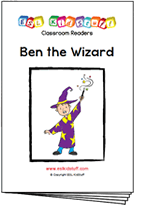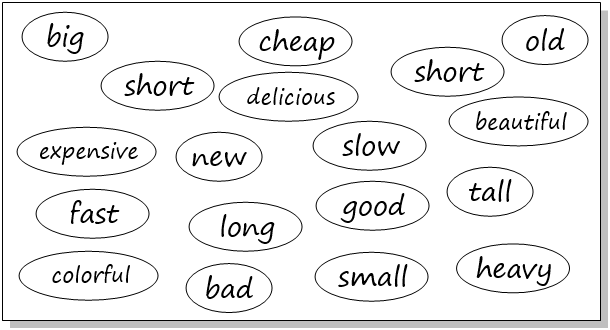Menu
Download the accompanying materials to this lesson plan - sign up here
Resources and materials for ESL Kids teachers
A comparative adjective compares differences between two nouns. For example, “The blue car is faster than the red car”.
Comparatives take the following forms:
This lesson will help your students describe the world around them and make comparisons. This lesson should be taught after the Describing Things (Adjectives) lesson as much of that lessons vocab will be recycled.
See our "Warm Up & Wrap Up" page.
1. Review and teach adjectives
Before class:
Before the lesson collect at least two of each of the following objects, pictures or flashcards:
Also, cut out the word cards - one set for each pair or group (and a set for yourself) - see last page of our printable lesson plan for word cards.
During class:
Scatter the objects / photos / flashcards randomly around the classroom (e.g. under tables, stuck to walls, on bookshelves, etc.). Students are going to match word cards to the objects around the room (see last page of this lesson plan for word cards).
Put students into pairs or small groups. Give each group a set of word cards. Tell the students they must find an object or picture that represents each word card and then place that word card next to the object or picture. Also explain that if the students don't know any of the words on the cards, they must guess which object to place it on.
Set a time limit (e.g. 5 minutes) and have the pairs / groups work together to place the cards next to the objects.
NOTE: allow and encourage students to place the word cards on other objects in the classroom, such as their bags (e.g. for heavy, old, colorful, etc.).
Once the time is up, get all the students to sit down in their groups. Ask different students to bring up the objects with their word cards and place them prominently at the front of the class (e.g. on a table). For each object, give a point to the team with the correct word card (e.g. a long pencil with the word card "long"). If there are any objects without a correct word card, teach the word for that object.
The team with the most points at the end is the winner.
2. Draw adjective pictures on the "Adjectives & Comparatives Pictures" worksheet
Give out the "Adjectives & Comparatives Pictures" worksheet to each student. Students continue to work in their same teams. Have students, using the objects and word cards at the front of the class for reference, draw pictures next to the words in the "adjectives" column (e.g. draw a tall man next to "tall" and a short man next to "short").
When everyone has finished, chorus all of the adjectives on the worksheet. Then have pairs work together: one points to pictures on the worksheet and their partner says the adjective, for example:
Student A: What's this?
Student B: A fast car.
Student A: And this?
Student B: A tall man.
etc.
Make sure students keep the worksheets as they will be using them again later in the lesson.
3. Teach comparative adjectives (adj+er / more + adj)
Take two of the people pictures that you used in the first activity. Stick them to the board. Under the shorter of the two, write "short". Point to the second person and teach/elicit "tall - taller" and write that under the picture, underlining the "er" part (taller).
Do this for a couple more ~er adjectives (e.g. short - shorter; long - longer; etc.).
Next, place two "expensive" object pictures on the board. Write "expensive" under one and then ask what should be written under the other. You will probably get the answer "expensiver" - here teach the other and write form (more expensive).
Then, do another more + adj on the board.
4. Write and draw comparatives on the "Adjectives & Comparatives Pictures" worksheet
Have the students take out their "Adjectives & Comparatives Pictures" worksheets again. Get them to have a go at writing all the comparative adjectives and draw pictures in the comparatives column.
For example, first point out the "taller" man and word in the first row, then model writing "smaller" and drawing a smaller man in the second row, comparative column.
As students are working on their worksheets circulate and help out. When everyone has finished, go through the worksheet by eliciting and writing the answers on the board. Make sure you focus on the following:
5. Students test each other on comparatives
Place students in pairs. Student A looks at his/her worksheet and Student B turns over his/hers. A starts by giving a short sentence with the adjective and B says the comparative form, for example:
Student A: An old book.
Student B: An older book.
Student A: A beautiful bird.
Student B: A more beautiful bird.
Pairs change roles after completing the test.
Finally, have all students turn over their worksheets and stand up. Say an adjective to each student and ask them to change your adjective example into a comparative. They can sit down if they give the correct answer. For example:
Teacher: David, a cheap car.
David: A cheaper car.
Teacher: Good job! You can sit down.
6. Play "Let's compare things around us"
Put students into pairs. Start by modeling the activity with a student. Walk around the class and point to something - say a short sentence using an adjective from the worksheet, such as "A cheap pencil case". Your partner then needs to find another pencil case in the class which s/he can compare it to, for example:
Teacher: (pointing) A cheap pencil case.
Student (pointing) A cheaper pencil case.
(or)
Student (pointing) A more expensive pencil case.
Then have pairs walk around the room making comparisons.
7. Read classroom reader "Ben the Wizard"
This reader helps to reinforce the vocab and structures practiced in the previous activities. Before class, download and print off the reader "Ben the Wizard". As you go through each page, point to the different spells Ben the Wizard is doing and elicit the adjectives and comparatives, for example:
 Teacher: (pointing at the top picture on page 2) What is this boy doing?
Teacher: (pointing at the top picture on page 2) What is this boy doing?
Students: He's running!
Teacher: Yes, that's right. Why is he running?
Students: To catch the bus!
Teacher: Yes, but why? Is he early or late?
Students: Late!
Teacher: Yes, he must be late. Do you think he can catch the bus?
Students: No!
Teacher: Why not?
Students: The bus is too fast!
Teacher: Right! So if the bus is too fast, the boy must be ... ?
Students: Too slow!
Teacher: Yes, good job! Now look here (pointing to the picture of Ben). He's casting another spell - zap! Now, is the boy too slow?
Students: No, he's faster!
Teacher: That's right, good job! Let's check (reading) "John is late for his bus to school! He’s not fast enough to catch it. Zap! Now he’s much faster!"
Continue through the story, eliciting the key vocab and structures. You can also try asking students to predict what spell Ben is going to cast by coving the second picture on each page with your hand.
After reading the story, give out a reader worksheet to each student and have everyone complete the sentences. Then go through the answers as a class.
---
Alternatively, watch our video version of the reader (Internet connection required):
8. Play the "Magazine pictures comparisons game"
For this activity you'll need to prepare lots of magazines or other print materials (such as catalogs, brochures, newspapers, books with pictures, etc.).
Start by writing all of the adjectives from today's lesson randomly on the white board, as follows:

Next, put students into groups of 3 or 4 and have each group sit around a table. Place a pile of magazines and other print materials in the middle of the table (as many as you can).
Elect a student to start the game in each group (Student A). Student A should flick through any of the magazines on the table and find a picture. They should then use one of the adjectives from the board to describe the picture, such as "A beautiful boat". On this cue, the rest of the students in the group need to search through the remaining magazines on the table to find a picture of the same object and say a comparative sentence (e.g. "A more beautiful boat").
As the games are being played, circulate and help out with vocab and mistakes. Let the games continue until at least everyone has had a couple of goes at choosing a picture.
Finally, do a class check: ask at least one student from each team to show you a comparison they made.
1. Assign Homework: "Compare things at home" worksheet.
2. Wrap up the lesson with some ideas from our "Warm Up & Wrap Up" page.
 Found a mistake?
Found a mistake?
Please let us know
Full access to all resources on ESL KidStuff including lesson plans, flashcards, worksheets, craft sheets,
song downloads, classroom readers, flashcards app and songs app.